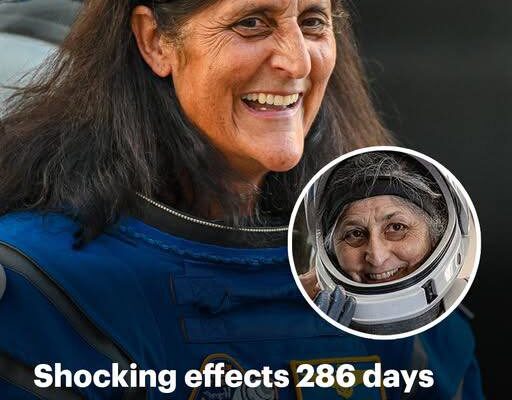After nine grueling months in space, NASA’s stranded astronauts have finally made their long-awaited return to Earth.
However, experts caution that Butch Wilmore and Suni Williams’ unexpected extended stay aboard the International Space Station (ISS) could have significant health consequences.
Stunning before-and-after images reveal the startling toll that months in the unforgiving environment of space can take on the human body.
From “chicken legs” and “baby feet” to an increased risk of cancer, experts warn that the stranded astronauts may face years of health complications.
As Williams, 59, and Wilmore, 62, emerged from their SpaceX Crew Dragon capsule yesterday, medical teams quickly assisted them onto stretchers—a standard procedure for returning astronauts, as prolonged weightlessness weakens muscles, making it difficult to walk under Earth’s gravity.
The duo will now undergo intensive medical evaluations at NASA’s Johnson Space Center in Houston. However, health experts have already observed signs of physical decline.
Even during their time on the ISS, concerns were raised about their gaunt appearance and noticeable weight loss.


After nine gruelling months in space, Suni Williams (pictured) and Butch Wilmore have finally returned to Earth. But shocking before-and-after images show the damage that their unintended stay in space has caused


Even during their time in space, health experts raised concerns that Butch Wilmore (pictured) and Suni Williams were suffering from severe weight loss and muscle atrophy


During their nine months on the ISS, health experts raised concerns over Williams’ ‘gaunt’ appearance. A loss of appetite is common in space due to frequent nausea, sometimes leading to astronauts losing dangerous amounts of weight


The biggest impacts of time in space are caused by exposure to microgravity and intense radiation. Being away from Earth’s pull causes astronauts’ muscles to weaken, leaving them with walking issues upon return
Vision Loss and Cognitive Decline
Beyond its unusual appearance, fluid buildup in the head can lead to serious medical complications.
As pressure increases, it compresses the eyes and optic nerves, resulting in Spaceflight-Associated Neuro-Ocular Syndrome (SANS). Over time, microgravity alters the shape of the eye, causing optic nerve swelling, flattening of the eye’s back, and retinal folds.
SANS affects approximately 70% of astronauts, leading to blurry or fuzzy vision. While studies suggest that most astronauts’ vision returns to normal after returning to Earth, NASA warns that some effects can be permanent.
The longer astronauts remain in space, the greater the risk of lasting vision damage—raising concerns for Williams and Wilmore, given their exceptionally long mission.
Additionally, shifting brain pressures, combined with stress and sleep deprivation, have been linked to cognitive decline in some astronauts.
astronauts.


As microgravity causes fluid to shift into the head, this not only causes a change in appearance but can also lead to vision loss in a condition called Spaceflight Associated Neuro-Ocular Syndrome (SANS)


Around 70 per cent of astronauts experience some vision loss, with the symptoms becoming worse the longer they are in space. This will be an especial concern given Suni William’s exceptionally long stay in space


In addition to the physical issues, Williams and Wilmore are also at risk of cognitive decline. Studies have shown that astronauts display slower processing and weakened short-term memory while in space


Although low-gravity, stress and lack of sleep lead to cognitive decline while astronauts are in space, research has shown that these symptoms abate back on Earth
Studies show that astronauts perform certain tasks significantly slower in space compared to on Earth.
Research also indicates impairments in working memory and attention, along with changes in risk-taking behavior.
However, there is currently no evidence that these cognitive changes persist after astronauts return to Earth.
Muscle and Bone Loss
One of the greatest risks of prolonged space travel is the impact of microgravity on the body.
Without Earth’s gravitational pull, astronauts’ muscles weaken from lack of use, leading to muscle atrophy that leaves them frail upon their return.
To counteract these effects, astronauts follow a strict exercise regimen, working out for at least two hours per day aboard the ISS.


Time spent in microgravity leads to a loss of muscle and bone mass which can be severe and long-lasting


Research has shown that a 30 to 50-year-old astronaut who spends six months in space loses about half their strength
Despite NASA’s rigorous exercise protocols, astronauts still experience significant muscle and bone loss, doctors told the Daily Mail.
“Astronauts who spend long periods in low gravity lose musculature and bone density,” said Dr. Jaquish. “The human body needs Earth’s gravitational pull, and without it, many systems don’t function properly.”
Research shows that a 30- to 50-year-old astronaut loses about half their strength after just six months in space. Upon returning to Earth, they often struggle to walk under the crushing force of gravity, as seen during yesterday’s dramatic landing.
Even with daily workouts on the ISS, both Williams and Wilmore had to be assisted out of their capsule and placed on stretchers.
Bone density loss can be severe and long-lasting, increasing the risk of fractures and skeletal issues.
Dr. Vinay Gupta, a pulmonologist and Air Force veteran, noted that the astronauts may require up to six weeks of rehabilitation, including guided exercise and a specialized nutrition plan, to rebuild their strength.


The impacts of microgravity are worsened by the fact that astronauts often struggle to maintain their weight in space


Weight Loss in Space
The effects of microgravity are compounded by the challenge astronauts face in maintaining their weight during extended missions.
Frequent nausea, along with a diminished sense of smell and taste due to sinus pressure, often leads to a loss of appetite.
In November, doctors told DailyMail.com that Williams appeared “gaunt” in a photo taken in September, suggesting noticeable weight loss.
Later that month, an unnamed NASA source told the New York Post that the agency was working to “stabilize the weight loss and hopefully reverse it.”
The insider, reportedly “directly involved with the mission,” revealed that Williams had struggled to keep up with the high-caloric diet required in space.
“The pounds have melted off her, and she’s now skin and bones. So it’s a priority to help her stabilize the weight loss and hopefully reverse it,” the source said.
However, Williams later addressed these concerns in a live NASA video, dismissing the weight loss “rumors” and claiming she had actually gained muscle.


Frequent nausea and a loss of smell and taste due to pressure in the sinuses means that astronauts lose their appetites
Fluid Shift in Space
With the human body being 70% water, fluid distribution changes dramatically in low gravity.
NASA explains that, much like hanging upside down, over 5.6 liters of fluid can migrate upward within the body.
This shift often results in a condition known as puffy face syndrome, causing noticeable swelling in the head. Meanwhile, the loss of fluid in the lower body leads to what NASA terms chicken legs and baby feet—a condition where the legs appear unusually thin and weak.
While these cosmetic effects typically subside within a few days of returning to Earth’s gravity, fluid redistribution can also pose serious health risks.
One major concern is an increased risk of blood clots due to a condition called Spaceflight Venous Thrombosis (SVT), which can have severe medical consequences for astronauts.


Suni Williams ‘gaunt’ appearance sparked concerns that she may be undergoing severe weight loss. However, Williams maintains that her changed appearance was due to fluid shifting into her face in microgravity


Months spent in low gravity cause fluid shifts in the body which can cause health problems ranging from ‘chicken legs’ to vision loss
Some astronauts who develop Spaceflight Venous Thrombosis (SVT) fully recover upon returning to Earth, while others require further medical treatment, according to NASA.
Radiation Exposure
During their extended ISS mission, Williams and Wilmore were exposed to extreme levels of space radiation.
In just one week aboard the ISS, astronauts absorb the equivalent of a full year’s radiation exposure on Earth.
More concerning, the type of radiation encountered in space is far more dangerous than common terrestrial sources.
Space radiation consists of high-energy particles—atoms stripped of their electrons as they accelerate to nearly the speed of light.
Astronauts must also contend with solar flares ejecting charged particles, as well as galactic cosmic rays—high-energy protons and heavy ions from beyond our solar system.
When these particles collide with the body, they break DNA strands, causing mutations that can lead to cancer.


While in space astronauts face increased exposure to dangerous space radiation, this means that Butch Wilmore (pictured) now has a significantly greater risk of developing cancer
Increased Health Risks
Exposure to space radiation may heighten the risk of cancer, central nervous system damage, bone loss, and cardiovascular diseases, according to NASA.
“If I were their physician, I would consider a more proactive approach to cancer screening,” said Dr. Gupta.
“Given their unique exposure history, we need to take a different strategy here,” he added.
Heart Health Concerns
It’s not just muscles and bones that suffer in space—low gravity also affects the cardiovascular system.
With fluids shifting upward toward the head, the heart doesn’t have to work as hard to maintain blood flow to the brain.
As a result, astronauts experience a reduction in blood volume and diminished heart and blood vessel function, according to NASA.
Skin problems


Despite leaving Earth in good condition, NASA’s astronauts will now need months of health checks and rehabilitation to recover
Studies have shown that spending six months aboard the ISS significantly impacts the skin.
One research team found that astronauts’ epidermis thins by nearly 20% in space, possibly due to low gravity, which may disrupt the skin’s ability to grow and repair itself.
Another study revealed that skin rashes are the most commonly reported clinical symptom during six-month ISS missions, occurring 25% more frequently than in the general US population on Earth.
These rashes may be triggered by irritants or allergens inside the space station, as well as the weakening effects of low gravity on the immune system. Skin lesions also take longer to heal in space, according to NASA.
Astronaut Recovery
To help astronauts recover from these long-term effects, NASA has developed a specialized rehabilitation program for those returning from space.
Examinations begin immediately upon exiting the capsule, followed by a transfer to NASA’s Johnson Space Center in Houston for several days of routine health checks.
Astronauts returning from extended ISS missions undergo a 45-day rehabilitation program, which includes two hours of daily exercise, seven days a week.

To maintain some of their strength, astronauts exercise for at least two hours per day on the ISS. Pictured: Sunita Williams uses the space station’s stationary bike during her 2012 mission
NASA tailors each astronaut’s post-mission rehabilitation program to their specific needs.
Phase One
This phase may include gait training, range-of-motion exercises, and obstacle training.
Gait training exercises are designed to enhance strength, balance, and coordination while walking. These may include squats, straight leg raises, standing on one leg, and seated marching.
To improve range of motion, astronauts may perform ankle pumps—flexing their feet while sitting or lying down. Stretching exercises for the calves, quadriceps, and hamstrings are also common.
Astronauts may also navigate obstacle courses, stepping over and around objects to further improve their coordination.
Phase two

Sunita Williams runs on the ISS treadmill during her 2012 mission
After making progress in phase one, astronauts move on to Phase Two, which incorporates proprioceptive exercises and cardio reconditioning.
Proprioceptive exercises strengthen the body while improving the mind’s awareness of its movement and position.
Examples include reverse lunges, banded toe taps, and sumo squats with leg raises. Some exercises are more complex, such as picking up an object from the floor while standing on one leg, requiring the astronaut to hinge at the waist and maintain balance as they bend down.
For cardio reconditioning, astronauts use equipment like a treadmill, elliptical, or stationary bike to restore their endurance to pre-flight levels.
Phase Three
Phase Three, the longest phase, focuses on restoring astronauts to their optimal physical performance through functional development training.
This training helps them regain the skills necessary for their work and daily activities, ensuring they can perform tasks with ease and efficiency once back on Earth.

Sunita Williams and the rest of the ISS crew performed Olympic events on the space station last summer

NASA astronaut Raja Chari performs strengthening exercises after returning from a 177-day-long ISS mission
It may involve higher-intensity exercises, such as jump squats, jump lunges, mountain climbers, planks, and deadlifts.
According to NASA, most astronauts reach their pre-mission fitness level after completing the 45-day program.
However, for some, recovery can take months or even years, and research has shown that many astronauts never fully regain their bone density.
Dr. John Jaquish, a biomedical engineer, told Daily Mail that astronauts could potentially recover their pre-flight bone density through osteogenic loading, though it will be challenging.
Osteogenic loading involves exercises that apply stress to bones, such as squats, lunges, or jumping, to stimulate bone strength.
To encourage bone growth, the astronauts would need to bear a load 4.2 times their body weight, according to Dr. Jaquish.
For context, “the world record squat is only four times body weight, so the minimum weight required for recovery is more than what record holders lift,” he explained.



